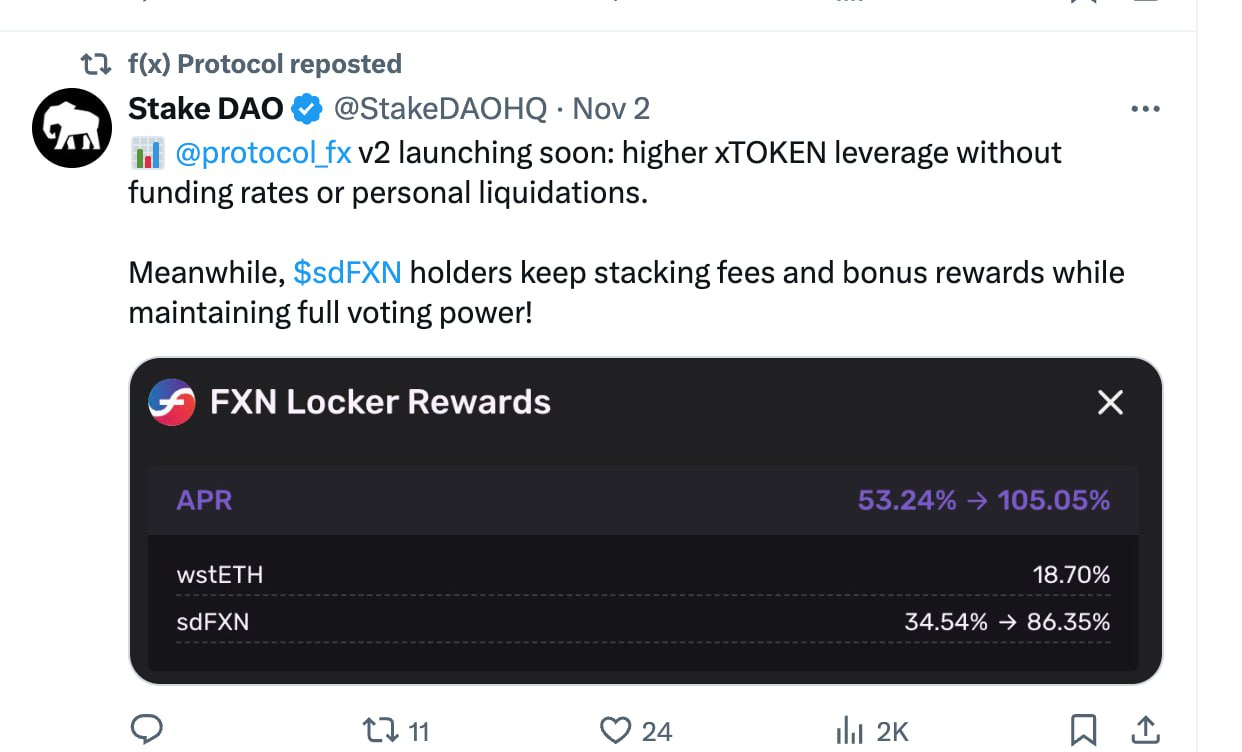Author: Kazuma, the Researcher from BlockBooster
Currently, most decentralized stablecoins on the market tend to be inefficient, often requiring over-collateralization primarily to cope with the high volatility of underlying reserve assets. This inefficiency limits the scalability of stablecoins, making it difficult for crypto users to use them in their daily lives. If there were a stablecoin that could strip away some volatility and provide that volatility to users seeking higher yields, would users be more willing to accept it?
f(x)Protocol is a brand new DeFi protocol that aims to achieve this by splitting collateral assets into low-volatility tokens and high-volatility tokens. The low-volatility tokens support its stablecoin, while the high-volatility tokens allow users to gain returns from price fluctuations of the underlying assets through leverage. The core stablecoin of the protocol, fxUSD, is pegged to the US dollar and is built on an innovative split token mechanism, with ETH as the underlying collateral asset.
Growth Performance of f(x)Protocol in 2024
In 2024, the total value locked (TVL) in f(x)Protocol grew by 273% from $15 million to today's $56 million. At the same time, the platform launched several stablecoins based on the same mechanism but using different collateral assets, such as:
- rUSD: backed by liquid staking tokens (LRTs)
- btcUSD: backed by Bitcoin
Additionally, in June 2024, f(x)Protocol launched an auto-compounding version of rUSD, arUSD, which allows users to earn additional yields from the underlying LRT assets.
As the DeFi sector recovers, f(x)Protocol is preparing for the release of its V2 version in December 2024 and has previewed some content from its white paper. Project partners such as StakeDAO and Convex are also looking forward to the V2 version.


(Source: X)
Highlights from the Newly Released V2 Version White Paper of f(x)Protocol
On November 5, f(x)Protocol announced the V2 version white paper, which shifts its focus more towards leveraged xPositions as a means to promote the effective utilization of fxUSD. Here are the key features:
1. Higher Leverage Ratios:
The V1 version of xPositions allowed users to obtain variable leverage on underlying assets through X-tokens, but the leverage ratio fluctuated based on market demand for fxUSD. In the V2 version, users can directly open fixed-leverage xPositions with leverage ratios of up to 10 times, without needing to mint X-tokens in their wallets. To support higher leverage ratios while maintaining system stability, the protocol automatically mints a certain amount of fxUSD through flash loans to ensure that the total collateral of X-tokens matches the leverage ratio chosen by the user.
2. No Single Point of Liquidation Risk:
The V2 version introduces a Rebalance Mechanism. When the risk of xPositions approaches the liquidation threshold, the system automatically redeems some minted fxUSD to avoid the common "liquidation" risk found in traditional DeFi protocols.
3. Dollar-Based Delta-Neutral Stability Pool:
The V2 version introduces a brand new Stability Pool, allowing users to deposit USDC or fxUSD with one click, providing liquidity support for the protocol's stability. Unlike the V1 version's stability pool, the V2 version's stability pool acts as an anchoring stabilizer between USDC and fxUSD, ensuring that the value of user deposits is denominated in dollars. Through the V2 version's stability pool, participants can earn yields in the following ways:
- Price arbitrage in the fxUSD/USDC AMM pool
- Trading and rebalancing fees paid by X-token traders
The entire process requires no execution or management of complex strategies, making it simple and user-friendly, with more transparent sources of income.
4. "Zero Funding Cost" for Specific Assets:
The V2 version offers a "zero funding cost" design for certain specific assets, further reducing users' trading costs.
Operation Mechanism of fxUSD
To better understand these innovative mechanisms and how they will help fxUSD truly become a scalable, high-yield decentralized stablecoin, let's take a deeper look at the current state of the f(x) protocol and its underlying technology.
f(x)Protocol adopts a dual-token mechanism, splitting the underlying assets into fxUSD (stablecoin) and xPositions (leverage). In the V1 version, users needed to deposit collateral assets first to mint fxUSD or X-tokens (xPositions) separately. In the V2 version, users can directly exchange assets for fxUSD through the CowSwap aggregator. Additionally, the V2 version allows users to directly open xPositions without going through the step of minting X-tokens, further simplifying the operational process.
Core Mechanism of fxUSD:
- Users deposit stETH into f(x)Protocol to mint fxUSD or xPositions, with assets supported by underlying dollar assets.
- As the price of the underlying assets changes, the redeemable reserve value for users will also change, but xETH (X-token) will first bear the volatility to make up the difference.
- When the price of ETH falls, the value of X-tokens will drop by a larger proportion, as xETH represents a leveraged position, while fxUSD remains pegged to the US dollar.
- When the price of ETH rises, the system remains fully collateralized, and xPosition holders enjoy leveraged gains.
To further maintain the stability of fxUSD, users can deposit stablecoins of liquid assets into the stability pool to earn native yield from stETH, as well as emissions in the form of the protocol's native FXN tokens, which include trading and rebalancing fees in V2.
Unique Advantages of f(x)Protocol
In the competitive decentralized stablecoin market (such as DAI, LUSD), f(x)Protocol has achieved rapid growth through the following innovative designs:
1. No Need for Over-Collateralization:
Unlike other decentralized stablecoins that rely on over-collateralization to cope with asset volatility, f(x)Protocol concentrates volatility on X-tokens through the dual-token design of fxUSD (stablecoin) and X-tokens (xPositions), thus forming a stable leverage pairing. As a result, fxUSD can maintain a stable peg at a 1:1 ratio.
2. Diversified but Isolated Reserve Support:
The reserves of fxUSD consist of many whitelisted liquid staking tokens (LSTs), which provide support through their stability pools. However, the main reserve of fxUSD is separated from the LST stability pool, reducing the risk of a single asset while ensuring the capture of arbitrage opportunities arising from LST price fluctuations.
3. Incentive Mechanism Consistent with Stability Maintenance:
It is common practice for LST staking yields to be directly returned to depositors, regardless of whether the stablecoin circulates within the protocol. However, f(x)Protocol innovatively allocates part of the yields to users holding fxUSD and participating in maintaining the protocol's stability, which helps the health and development of the protocol.
4. Simplified Real Returns:
fxUSD provides users with an efficient way to earn multiple yields from the underlying stETH reserves, combined with inflation rewards from FXN tokens, which will be fully released into circulation within 50. Additionally, trading fees from X-token in the V2 version will further drive sustainable yield growth for the stablecoin, such as opening/closing xPositions and maintaining their liquidation fees.
To further protect the peg of its stablecoin, f(x) also employs a unique risk management mechanism:
- X-token is the first line of defense: It absorbs market price fluctuations, protecting the stability of F-token (stablecoin), while also providing a leveraged product for crypto players seeking high risk and high returns.
- What if X-token can't hold up? If price fluctuations are too large and exceed the tolerance of X-token, the protocol will redeem some F-tokens from the stability pool. For users, this is similar to a "liquidation," where they need to repurchase the underlying collateral assets at the current market price. However, to compensate for this risk, the protocol incentivizes users to participate in staking through underlying asset yields and token rewards.
- What happens in extreme situations? In a black swan event or market flash crash, X-tokens will not be directly destroyed like traditional liquidations but will go to zero (value zero). At this point, F-tokens will become the only tokens that can claim the underlying reserve assets. This also means that F-tokens will fluctuate 1:1 with the underlying assets.
Comparison of fxUSD with Other Stablecoins
Currently, most mainstream stablecoins in the market are pegged to the US dollar and rely on almost the same mechanisms to maintain this peg. However, they often differ in terms of collateral types, market sizes, and the degree of integration with the broader crypto ecosystem. Here is a comparison of fxUSD with other stablecoins in several key aspects:
fxUSD
Other Stablecoins (such as DAI, USDC)
Collateral Assets
Liquid staking assets such as stETH, LRT, and DeFi tokens
DAI relies on ETH; USDC/USDT relies on traditional financial assets
Collateral Ratio
1:1 fully collateralized, no need for over-collateralization
Typically requires 110%-150% over-collateralization
Adoption Level
Currently mainly used within the Ethereum ecosystem, gradually expanding integration with DeFi protocols (Spectra, StakeDAO, and Convex Finance)
Widely integrated into CEX and DEX, covering multiple public chains
Price Stability
fxUSD largely maintains asset peg and stability but has not been fully tested by the market
Stablecoins like USDC and USDT are backed by assets such as US Treasury bonds but have also decoupled during extreme market fluctuations
Market Capitalization
fxUSD has a circulating market cap of $10 million, with significant growth potential
DAI has a circulating market cap of over $3.3 billion
Risks and Challenges of f(x)Protocol
As mentioned earlier, launching a new stablecoin in such a competitive environment is not easy, and the f(x) protocol faces several obstacles in its efforts to increase the ecological applications of fxUSD:
- Intense Market Competition: Compared to established stablecoins like DAI and USDT, fxUSD still has a significant gap in market capitalization and application scope. However, after the V2 version upgrade, f(x) aims to promote fxUSD as a "Real Yield" stablecoin, focusing on optimizing its X-token products. The fees generated by X-token traders create a sustainable revenue flywheel for f(x), attracting more users with idle funds. This not only drives the growth of the f(x) ecosystem but also increases the application of fxUSD in the process.
- Potential Risks of the New Protocol: As an emerging protocol, its mechanisms have not yet fully undergone stress testing in the actual market, posing potential risks.
- Ecological Applications: Established stablecoins have been widely integrated into various DeFi protocols and blockchain ecosystems, giving them high practicality in broader scenarios, such as lending platforms. Currently, fxUSD only supports the Ethereum ecosystem, with limited application scenarios and a lack of cross-chain and broader DeFi integration. However, the protocol's stability pool offers higher yields compared to other platforms, which helps drive the growth and application of fxUSD.
Despite facing challenges, f(x)Protocol is gradually providing new value propositions for Web3 users through its innovative design of zero liquidation risk leverage and multi-yield stablecoins. In the future, with the launch of the V2 version, f(x)Protocol is expected to further expand its market share and become an important player in the decentralized stablecoin space.
免责声明:本文章仅代表作者个人观点,不代表本平台的立场和观点。本文章仅供信息分享,不构成对任何人的任何投资建议。用户与作者之间的任何争议,与本平台无关。如网页中刊载的文章或图片涉及侵权,请提供相关的权利证明和身份证明发送邮件到support@aicoin.com,本平台相关工作人员将会进行核查。




